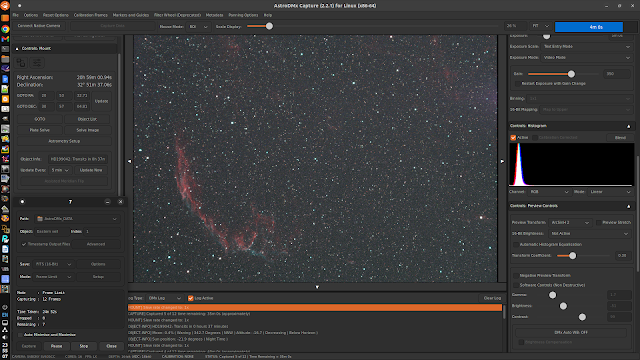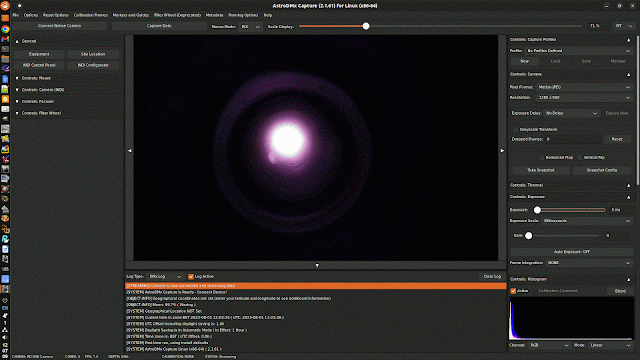The Soap Bubble planetary nebula (PN G75.5+1.7) is not an obvious, or easy object to see or image. It lies quite close to the Crescent nebula in Cygnus and yet was only discovered in 2007 by amateur astronomer Dave Jurasevich using an Astro-Physics 160 mm EDF air-spaced triplet apochromatic refractor .
He imaged the nebula on June 19, 2007 at f/7.7 and again on July 6, 2008 at f/5.7.
On July 26, 2013 the Centre de Données Astronomiques de Strasbourg (CDS), the world referenece database for the identification of astronomical objects officially designated PN G75.5+1.7 as Ju1 (Jurasevich 1).
The central coordinates of the Soap Bubble nebula are RA. = 20h15m22.2s, DEC. = +38d02'58" (J 2000)
The star HD 228550 is closely adjacent to the Soap Bubble nebula. The star HD192537 is mid way between the Soap Bubble nebula and the Crescent nebula.
We made a first attempt at imaging the Soap Bubble nebula with AstroDMx Capture using a William Optics Super Zenithstar 81mm ED Doublet APO refractor at f/5.5 with x0.8 flattener/reducer fitted with an Altair magnetic filter holder version 2 containing an Altair Quadband filter. The camera used was an SV405CC 14 bit, cooled OSC CMOS camera.
The equipment used
As usual, the mount was placed on marks on the ground which gives a good polar alignment when care is taken with the placement of the tripod feet.
PHD2 was used for multi-star pulse auto-guiding and was controlled by a separate Linux computer indoors.
Screenshot of the PHD2 auto-guiding computer
AstroDMx Capture captured the data, controlled the mount and the ZWO EAF via an INDI server running on the imaging computer indoors.
AstroDMx Capture was used to send the scope/mount to Altair; with plate-solving to centre the star. The scope was then focused using a Bahtinov Mask.
AstroDMx Capture was used to send the scope/mount to the star HD 228550 (close to the Soap Bubble nebula), automatically, repeatedly plate solve and move until an accuracy of 5 arc-seconds was achieved,
AstroDMx Capture was used to capture 1.5 hours worth of 5 minute exposures of the Soap Bubble region.
The Crescent nebula is visible on the preview screen as well as some general nebulosity.
Dark frames, Flatfields, Dark-flats and Bias frames were also captured during the session.
The Quadband filter used
The Altair Quadband OSC narrowband filter transmits two spectral bands:
FWHM spans 477.5nm - 512.5nm at the blue-green end of the visible spectrum and FWHM spans 642.5nm - 677.5nm at the red end of the spectrum.
The first band contains the emission lines of H-beta at 486.1nm and OIII at 495.9nm and 500.7nm and is centred on 495nm.
The second band contains the emission lines of H-alpha at 656.3nm and SII at 672.4nm and is centred on 660nm.
The Filter is called ‘Quadband’ because it transmits the emission lines of these four elements.
Each of the two transmission bands has a FWHM of 35nm and the rest of the visible spectrum is essentially blocked.
The data were calibrated and stacked in Deep Sky Stacker. The Starnet++ Gimp plugin was used to remove the stars and the resulting image was decomposed into the 3 RGB channels. The Blue and Green channels were merged to produce a synthetic O channel and the Red channel that would also cntain any SII data was used as a synthetic H channel. The two synthetic channels were stretched to reveal as much of the captured nebulosity as possible. The channels were re-composed as a synthetic HOO image, which was post processed in the Gimp 2.10 and Neat Image.
Synthetic HOO image of the Soap Bubble region
The Soap Bubble nebula is by no means easy to spot, however it contains a characteristic group of six stars which verify its location.
Diagrams of the Soap Bubble nebula
Animation showing the location of the Soap Bubble nebula (PN G75.5+1.7) in the above image
With the aids used above, it is just possible to make out the Soap Bubble nebula amongst all of the local nebulosity.
The data used here comprise One and a half hour’s data comprising 5 minute exposures.
However, Dave Jurasevich first imaged the Soap Bubble nebula on July 19, 2007 with a single 30 minute exposure using an SBIG STL - 11000 M CCD camera and his 160mm refractor at f/7.7 using a 6nm H-alpha filter.
Subsequently, on July 5, 2008 using the same equipment but at f/5.7 he imaged the nebula using 4 hour’s worth of data comprising 12 x 20 minute exposures.
In future attempts to image the nebula we shall use an SV605MC mono, cooled, 14 bit CMOS camera and a 7nm Altair H-alpha filter.
























































